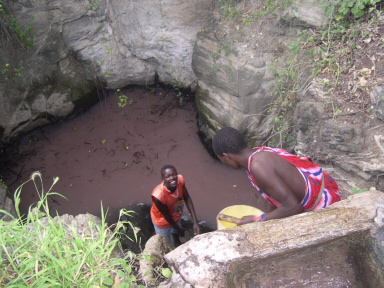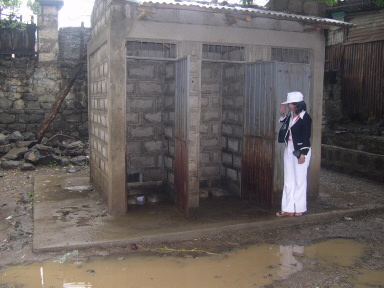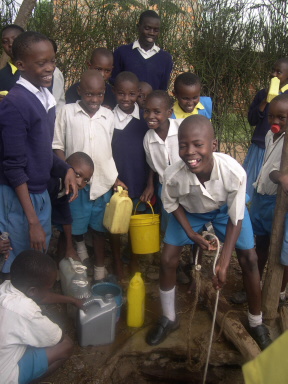Contribute
| Water And Sanitation – The Next Global Challenge |
Raj Melville
06/26/2008
Even as we go about our daily lives in the west knowing that we can duck into a McDonalds to use the loo or grab a bottle of soda to quench our thirst, nearly half the world’s population has to make do without the simplest access to basic sanitation and clean water. The UN estimates over a billion people (or nearly a sixth of the world’s population) manages without clean water. According to the World Health Organization, over 4 billion cases of diarrhea occur each year around the world, 88% of which is attributable to unsafe water or inadequate hygiene or sanitation. Nearly 1.8 million people die of diarrhea each year, the majority of whom are children.
The UN’s Millennium Development Goals renewed the focus on addressing water and sanitation issues. In 2002, the World Summit on Sustainable Development added access to basic sanitation as a centerpiece to poverty eradication efforts with a target to halve the proportion of people without access to basic sanitation by 2015. The UN has declared 2008 as the International Year of Sanitation.
According to a reader survey in the British Medical Journal, sanitation is the most important medical advance since 1840. Improved sanitation has the ability to reduce diseases that cause disease and death to millions. According to a recent WHO study, every dollar spent on improving sanitation generates an average economic benefit of $7. However, despite significant efforts by governments, progress on sanitation targets has been slow and uneven
Slowly around the world both corporations and non-profits have been stepping up to the challenge and making significant strides. Major corporations like Coca Cola and Pepsi have focused a significant portion of their corporate community efforts on addressing water related issues. The increasing concern, especially in the developing world, about the demand on local water resources in processing of carbonated beverages has got these giants pledging to reduce water consumption. Today, Coca Coal consumes 76 billion gallons of water a year to make its range of sodas. Announcing a new initiative in June 2007, Coca Cola’s CEO, E. Neville Isdell said, “Essentially the pledge is to return every, every drop we use back to natureâ€. Working with NGOs in developing countries, Proctor & Gamble has developed a low cost water purification sachet that is being used to bring affordable, clean water to rural areas.
In India, a number of NGOs are working in this field. Water for People has been working in West Bengal to bring tube wells, arsenic removal filters and public use sanitation facilities to the rural poor. WaterAid has been working with community organizations in rural as well as poor urban areas to pressure the government to include adequate water and sanitation infrastructure. By creating village water and sanitation committees they help people to manage projects that get the entire community involved. In rural areas, activities like rainwater harvesting and rechanneling of waste water help recharge the ground table and improve otherwise drought prone conditions.
In Boston, a startup non-profit, Water Centric, launched by Lotika Paintal, is focused on providing water and sanitation to schools in underserved segments of urban and rural India. School going children represent a large and vulnerable segment of society. Currently around half the schools in the developing world do not have access to clean water. Nearly 75% do not have access to adequate sanitation. The lack of sanitation and privacy increases absenteeism particularly among girls. By focusing on providing functional toilets, access to clean water coupled with in-class modules on hygiene, Water Centric expects to increase awareness and improve basic sanitation practices among the student population. Studies have shown that improving hygiene is the single most important factor in reducing diarrheal episodes. By involving teachers and the community in the process, Water Centric hopes to extend its impact beyond the school to affect the larger community.
To help raise awareness in the Boston area, Lotika is organizing a panel discussion on “Why water and sanitation is the next major global challenge?†on July 31st, 2008 at the MIT Stata Center. Featured speakers on the panel will include Denise D. Knight, of the Coca Cola Company’s Water Sustainability Initiative, Michael Delaney, Director of Oxfam America’s Humanitarian response and others. The panel will be moderated by Lotika Paintal. The panel will discuss some of the major challenges in addressing this pervasive issue and what are some of the innovative solutions that are being implemented. Additional information can be found at www.tie-boston.org
For more information on some of the organizations in this article:
* Water Centric: http://www.watercentric.org/
* Water Aid: http://www.wateraid.org/
* Water for People: http://www.waterforpeople.org
* Coca Cola’s Water Stewardship:
http://www.thecoca-colacompany.com/citizenship/water_main.html
* P&G’s Children’s Safe Drinking Water Initiative: http://csdw.org/index.shtml
(All photos with this article are courtesy of Lotika Paintal/Water Centric)
You can contact me with ideas, suggestions or for more information at:
SELokvani@gmail.com
You can continue this dialog on my blog at: http://socialecosystem.wordpress.com/
You may also access this article through our web-site http://www.lokvani.com/

Figure 1 Boys from nomadic Masai tribes gather water from the only sources available (Copyright Lotika Paintal/Water Centric)

Figure 2 Even when school toilets are available; they are neither functional nor hygienic (Copyright Lotika Paintal/Water Centric)

Figure 3 Kenyan school boys line up precariously to fill water at an unprotected community well (Copyright Lotika Paintal/Water Centric)